Should the wills of the tide dynamic just a name is the salt its master,
does the noun scribe,
how on earth is ground the gourde of sky,
shifting to a grace of more than a magnitude,
I sport only the inhuman to Mankind.
Scream if that is your forest and desert this as only sand,
tribe of Man does only the hand tree to see the fan,
did the write only left as the letters made morse to code,
should the swear be hell or is it heck that directs Man to know comprehension.
Does it punctuate,
where are the stones,
a cobbled road is in the rain and yet,
it buries before the storm.
Dancing only on an exit I process,
my mind is not that station of letter as the alphabet would envelope,
the paper would have had to have had a tree,
sand would have had to have scratched the foot or left a print in the wave,
this is the note.
Music I implore your piano of the dice that said snake eyes,
gamble not the roulette,
for on the floor is the earth and that makes the sidewalk a curb to understand the sign.
Each passing moment is not a minute to me,
also the rain is not the raisen in the Sun to be foiled,
grape is not the juice and yet,
yet,
the question that said 'is it the names' that corks the wine,
is the glass of stemware or the dinner plate that was write,
shall not the circle of pen drops round the ink and explain more than explore.
Death is but the grave,
night that hour of cloud to answer with the breadth of life itself,
raise this to your mind and navigate that three syllable word as if it sentenced,
break away from the banter and lift not a taxi,
do the vehicle as you would have done the light,
this is not the message of a bottle to written the corn of what is a heel,
shake what is and show to the worth that wealth is but a corn,
no cope will deal,
court not the detail of wealth as the coin does flip to meant,
knod your nothing as innocent is not a word to be foiled,
guilty is not a commitment to speak of the gene that is between your legs,
what shaft would not counter to the stiff should death not finalize this worlds path,
it is on that table of morgue that rich becomes pictured,
nigh this hour to what is the tomb of completion,
it is the thought.
A leading cause of death does math,
it is the mind that brings more to this conversation,
press is only short for sure as the wording develops,
back to the picture,
is it Scream?
Is it possible that the sentence is the word that made a saming game that extended to this day of stun,
shall the ring and the rose see sing,
does cemetary declare stop the agony and remember the Man,
dancing only lightly with keyboard and click to describe,
is it the screen,
or,
is it simple Means?
Edvard Munch
Jump to navigation
Jump to search
Edvard Munch (/mʊŋk/;[1] Norwegian: [ˈedvɑʈ ˈmuŋk] ( listen); 12 December 1863 – 23 January 1944) was a Norwegian painter and printmaker whose intensely evocative treatment of psychological themes built upon some of the main tenets of late 19th-century Symbolism and greatly influenced German Expressionism in the early 20th century. His best known work is The Scream, painted in 1893.
listen); 12 December 1863 – 23 January 1944) was a Norwegian painter and printmaker whose intensely evocative treatment of psychological themes built upon some of the main tenets of late 19th-century Symbolism and greatly influenced German Expressionism in the early 20th century. His best known work is The Scream, painted in 1893.
| Edvard Munch | |
|---|---|
 | |
| Born |
12 December 1863 Ådalsbruk, Løten, United Kingdoms of Sweden and Norway |
| Died |
23 January 1944 (aged 80) Oslo, Norway |
| Nationality | Norwegian |
| Known for | Painting and graphic artist |
| Notable work | The Scream, Madonna, The Sick Child |
| Movement | Expressionism, Symbolism |
Contents
Life
Childhood
Edvard Munch was born in a farmhouse in the village of Ådalsbruk in Løten, United Kingdoms of Sweden and Norway, to Laura Catherine Bjølstad and Christian Munch, the son of a priest. Christian was a doctor and medical officer who married Laura, a woman half his age, in 1861. Edvard had an elder sister, Johanne Sophie, and three younger siblings: Peter Andreas, Laura Catherine, and Inger Marie. Laura was artistically talented and may have encouraged Edvard and Sophie. Edvard was related to painter Jacob Munch and to historian Peter Andreas Munch.[2]The family moved to Christiania (renamed Kristiania in 1877, and now Oslo) in 1864 when Christian Munch was appointed medical officer at Akershus Fortress. Edvard's mother died of tuberculosis in 1868, as did Munch's favorite sister Johanne Sophie in 1877.[3] After their mother's death, the Munch siblings were raised by their father and by their aunt Karen. Often ill for much of the winters and kept out of school, Edvard would draw to keep himself occupied. He was tutored by his school mates and his aunt. Christian Munch also instructed his son in history and literature, and entertained the children with vivid ghost-stories and the tales of American writer Edgar Allan Poe.[4]
As Edvard remembered it, Christian's positive behavior toward his children was overshadowed by his morbid pietism. Munch wrote, "My father was temperamentally nervous and obsessively religious—to the point of psychoneurosis. From him I inherited the seeds of madness. The angels of fear, sorrow, and death stood by my side since the day I was born."[5] Christian reprimanded his children by telling them that their mother was looking down from heaven and grieving over their misbehavior. The oppressive religious milieu, Edvard's poor health, and the vivid ghost stories helped inspire his macabre visions and nightmares; the boy felt that death was constantly advancing on him.[6] One of Munch's younger sisters, Laura, was diagnosed with mental illness at an early age. Of the five siblings, only Andreas married, but he died a few months after the wedding. Munch would later write, "I inherited two of mankind's most frightful enemies—the heritage of consumption and insanity."[7]
Christian Munch's military pay was very low, and his attempts to develop a private side practice failed, keeping his family in genteel but perennial poverty.[3] They moved frequently from one cheap flat to another. Munch's early drawings and watercolors depicted these interiors, and the individual objects, such as medicine bottles and drawing implements, plus some landscapes. By his teens, art dominated Munch's interests.[8] At thirteen, Munch had his first exposure to other artists at the newly formed Art Association, where he admired the work of the Norwegian landscape school. He returned to copy the paintings, and soon he began to paint in oils.[9]
Studies and influences
Self-Portrait with Skeleton Arm, 1895
In 1881, Munch enrolled at the Royal School of Art and Design of Kristiania, one of whose founders was his distant relative Jacob Munch. His teachers were sculptor Julius Middelthun and the naturalistic painter Christian Krohg.[12] That year, Munch demonstrated his quick absorption of his figure training at the Academy in his first portraits, including one of his father and his first self-portrait. In 1883, Munch took part in his first public exhibition and shared a studio with other students.[13] His full-length portrait of Karl Jensen-Hjell, a notorious bohemian-about-town, earned a critic's dismissive response: "It is impressionism carried to the extreme. It is a travesty of art."[14] Munch's nude paintings from this period survive only in sketches, except for Standing Nude (1887). They may have been confiscated by his father.[15]
During these early years, Munch experimented with many styles, including Naturalism and Impressionism. Some early works are reminiscent of Manet. Many of these attempts brought him unfavorable criticism from the press and garnered him constant rebukes by his father, who nonetheless provided him with small sums for living expenses.[14] At one point, however, Munch's father, perhaps swayed by the negative opinion of Munch's cousin Edvard Diriks (an established, traditional painter), destroyed at least one painting (likely a nude) and refused to advance any more money for art supplies.[16]
Munch also received his father's ire for his relationship with Hans Jæger, the local nihilist who lived by the code "a passion to destroy is also a creative passion" and who advocated suicide as the ultimate way to freedom.[17] Munch came under his malevolent, anti-establishment spell. "My ideas developed under the influence of the bohemians or rather under Hans Jæger. Many people have mistakenly claimed that my ideas were formed under the influence of Strindberg and the Germans…but that is wrong. They had already been formed by then."[18] At that time, contrary to many of the other bohemians, Munch was still respectful of women, as well as reserved and well-mannered, but he began to give in to the binge drinking and brawling of his circle. He was unsettled by the sexual revolution going on at the time and by the independent women around him. He later turned cynical concerning sexual matters, expressed not only in his behavior and his art, but in his writings as well, an example being a long poem called The City of Free Love.[19] Still dependent on his family for many of his meals, Munch's relationship with his father remained tense over concerns about his bohemian life.
After numerous experiments, Munch concluded that the Impressionist idiom did not allow sufficient expression. He found it superficial and too akin to scientific experimentation. He felt a need to go deeper and explore situations brimming with emotional content and expressive energy. Under Jæger's commandment that Munch should "write his life", meaning that Munch should explore his own emotional and psychological state, the young artist began a period of reflection and self-examination, recording his thoughts in his "soul's diary".[20] This deeper perspective helped move him to a new view of his art. He wrote that his painting The Sick Child (1886), based on his sister's death, was his first "soul painting", his first break from Impressionism. The painting received a negative response from critics and from his family, and caused another "violent outburst of moral indignation" from the community.[21]
Only his friend Christian Krohg defended him:
He paints, or rather regards, things in a way that is different from that of other artists. He sees only the essential, and that, naturally, is all he paints. For this reason Munch's pictures are as a rule "not complete", as people are so delighted to discover for themselves. Oh, yes, they are complete. His complete handiwork. Art is complete once the artist has really said everything that was on his mind, and this is precisely the advantage Munch has over painters of the other generation, that he really knows how to show us what he has felt, and what has gripped him, and to this he subordinates everything else.[22]Munch continued to employ a variety of brushstroke techniques and color palettes throughout the 1880s and early 1890s, as he struggled to define his style.[23] His idiom continued to veer between naturalistic, as seen in Portrait of Hans Jæger, and impressionistic, as in Rue Lafayette. His Inger On the Beach (1889), which caused another storm of confusion and controversy, hints at the simplified forms, heavy outlines, sharp contrasts, and emotional content of his mature style to come.[24] He began to carefully calculate his compositions to create tension and emotion. While stylistically influenced by the Post-Impressionists, what evolved was a subject matter which was symbolist in content, depicting a state of mind rather than an external reality. In 1889, Munch presented his first one-man show of nearly all his works to date. The recognition it received led to a two-year state scholarship to study in Paris under French painter Léon Bonnat.[25]
Munch seems to have been an early critic of photography as an art form, and remarked that it "will never compete with the brush and the palette, until such time as photographs can be taken in Heaven or Hell!"[26]
Munch's younger sister Laura was the subject of his 1899 interior Melancholy: Laura. Amanda O'Neill says of the work, "In this heated claustrophobic scene Munch not only portrays Laura's tragedy, but his own dread of the madness he might have inherited."[27]
Paris
Munch arrived in Paris during the festivities of the Exposition Universelle (1889) and roomed with two fellow Norwegian artists. His picture Morning (1884) was displayed at the Norwegian pavilion.[28] He spent his mornings at Bonnat's busy studio (which included live female models) and afternoons at the exhibition, galleries, and museums (where students were expected to make copies as a way of learning technique and observation).[29] Munch recorded little enthusiasm for Bonnat's drawing lessons—"It tires and bores me—it's numbing"—but enjoyed the master's commentary during museum trips.[30][31]Munch was enthralled by the vast display of modern European art, including the works of three artists who would prove influential: Paul Gauguin, Vincent van Gogh, and Henri de Toulouse-Lautrec—all notable for how they used color to convey emotion.[31] Munch was particularly inspired by Gauguin's "reaction against realism" and his credo that "art was human work and not an imitation of Nature", a belief earlier stated by Whistler.[32] As one of his Berlin friends said later of Munch, "he need not make his way to Tahiti to see and experience the primitive in human nature. He carries his own Tahiti within him."[33] Influenced by Gauguin, as well as the etchings of German artist Max Klinger, Munch experimented with prints as a medium to create graphic versions of his works. In 1896 he created his first woodcuts—a medium that proved ideal to Munch's symbolic imagery.[34] Together with his contemporary Nikolai Astrup, Munch is considered an innovator of the woodcut medium in Norway.[35]
In December 1889 his father died, leaving Munch's family destitute. He returned home and arranged a large loan from a wealthy Norwegian collector when wealthy relatives failed to help, and assumed financial responsibility for his family from then on.[36] Christian's death depressed him and he was plagued by suicidal thoughts: "I live with the dead—my mother, my sister, my grandfather, my father…Kill yourself and then it's over. Why live?"[37] Munch's paintings of the following year included sketchy tavern scenes and a series of bright cityscapes in which he experimented with the pointillist style of Georges Seurat.[38]
Berlin
Munch in 1902, in the garden of his patron Dr. Max Linde in Lübeck; in the background is a cast of Auguste Rodin's sculpture Iron Era.
In Berlin, Munch became involved in an international circle of writers, artists and critics, including the Swedish dramatist and leading intellectual August Strindberg, whom he painted in 1892. He also met Danish writer and painter Holger Drachmann, whom he painted in 1898. Drachmann was 17 years Munch's senior and a drinking companion at Zum schwarzen Ferkel in 1893–94.[42] In 1894 Drachmann wrote of Munch: "He struggles hard. Good luck with your struggles, lonely Norwegian." [43]
During his four years in Berlin, Munch sketched out most of the ideas that would comprise his major work, The Frieze of Life, first designed for book illustration but later expressed in paintings.[44] He sold little, but made some income from charging entrance fees to view his controversial paintings.[45] Already, Munch was showing a reluctance to part with his paintings, which he termed his "children".
His other paintings, including casino scenes, show a simplification of form and detail which marked his early mature style.[46] Munch also began to favor a shallow pictorial space and a minimal backdrop for his frontal figures. Since poses were chosen to produce the most convincing images of states of mind and psychological conditions, as in Ashes, the figures impart a monumental, static quality. Munch's figures appear to play roles on a theatre stage (Death in the Sick-Room), whose pantomime of fixed postures signify various emotions; since each character embodies a single psychological dimension, as in The Scream, Munch's men and women began to appear more symbolic than realistic. He wrote, "No longer should interiors be painted, people reading and women knitting: there would be living people, breathing and feeling, suffering and loving."[47]
The Scream
The Scream (1893)
The 1895 pastel sold at auction on 2 May 2012 for US$119,922,500, including commission.[48] It is the most colorful of the versions[49] and is distinctive for the downward-looking stance of one of its background figures. It is also the only version not held by a Norwegian museum.
The 1893 version was stolen from the National Gallery in Oslo in 1994 and recovered. The 1910 painting was stolen in 2004 from The Munch Museum in Oslo, but recovered in 2006 with limited damage.
The Scream is Munch's most famous work, and one of the most recognizable paintings in all art. It has been widely interpreted as representing the universal anxiety of modern man.[47] Painted with broad bands of garish color and highly simplified forms, and employing a high viewpoint, it reduces the agonized figure to a garbed skull in the throes of an emotional crisis.
With this painting, Munch met his stated goal of "the study of the soul, that is to say the study of my own self".[50] Munch wrote of how the painting came to be: "I was walking down the road with two friends when the sun set; suddenly, the sky turned as red as blood. I stopped and leaned against the fence, feeling unspeakably tired. Tongues of fire and blood stretched over the bluish black fjord. My friends went on walking, while I lagged behind, shivering with fear. Then I heard the enormous, infinite scream of nature."[51] He later described the personal anguish behind the painting, "for several years I was almost mad… You know my picture, 'The Scream?' I was stretched to the limit—nature was screaming in my blood… After that I gave up hope ever of being able to love again."[52]
In summing up the painting's effects, author Martha Tedeschi has stated:
Whistler's Mother, Wood's American Gothic, Leonardo da Vinci's Mona Lisa and Edvard Munch's The Scream have all achieved something that most paintings—regardless of their art historical importance, beauty, or monetary value—have not: they communicate a specific meaning almost immediately to almost every viewer. These few works have successfully made the transition from the elite realm of the museum visitor to the enormous venue of popular culture.[53]
Frieze of Life—A Poem about Life, Love and Death
In December 1893, Unter den Linden in Berlin was the location of an exhibition of Munch's work, showing, among other pieces, six paintings entitled Study for a Series: Love. This began a cycle he later called the Frieze of Life—A Poem about Life, Love and Death. Frieze of Life motifs, such as The Storm and Moonlight, are steeped in atmosphere. Other motifs illuminate the nocturnal side of love, such as Rose and Amelie and Vampire. In Death in the Sickroom, the subject is the death of his sister Sophie, which he re-worked in many future variations. The dramatic focus of the painting, portraying his entire family, is dispersed in the separate and disconnected figures of sorrow. In 1894, he enlarged the spectrum of motifs by adding Anxiety, Ashes, Madonna and Women in Three Stages (from innocence to old age).[54]Around the start of the 20th century, Munch worked to finish the "Frieze". He painted a number of pictures, several of them in bigger format and to some extent featuring the Art Nouveau aesthetics of the time. He made a wooden frame with carved reliefs for the large painting Metabolism (1898), initially called Adam and Eve. This work reveals Munch's preoccupation with the "fall of man" and his pessimistic philosophy of love. Motifs such as The Empty Cross and Golgotha (both c. 1900) reflect a metaphysical orientation, and also reflect Munch's pietistic upbringing. The entire Frieze was shown for the first time at the secessionist exhibition in Berlin in 1902.[55]
"The Frieze of Life" themes recur throughout Munch's work but he especially focused on them in the mid-1890s. In sketches, paintings, pastels and prints, he tapped the depths of his feelings to examine his major motifs: the stages of life, the femme fatale, the hopelessness of love, anxiety, infidelity, jealousy, sexual humiliation, and separation in life and death.[56] These themes are expressed in paintings such as The Sick Child (1885), Love and Pain (retitled Vampire; 1893–94), Ashes (1894), and The Bridge. The latter shows limp figures with featureless or hidden faces, over which loom the threatening shapes of heavy trees and brooding houses. Munch portrayed women either as frail, innocent sufferers (see Puberty and Love and Pain) or as the cause of great longing, jealousy and despair (see Separation, Jealousy, and Ashes).
Munch often uses shadows and rings of color around his figures to emphasize an aura of fear, menace, anxiety, or sexual intensity.[57] These paintings have been interpreted as reflections of the artist's sexual anxieties, though it could also be argued that they represent his turbulent relationship with love itself and his general pessimism regarding human existence.[58] Many of these sketches and paintings were done in several versions, such as Madonna, Hands and Puberty, and also transcribed as wood-block prints and lithographs. Munch hated to part with his paintings because he thought of his work as a single body of expression. So to capitalize on his production and make some income, he turned to graphic arts to reproduce many of his most famous paintings, including those in this series.[59] Munch admitted to the personal goals of his work but he also offered his art to a wider purpose, "My art is really a voluntary confession and an attempt to explain to myself my relationship with life—it is, therefore, actually a sort of egoism, but I am constantly hoping that through this I can help others achieve clarity."[60]
While attracting strongly negative reactions, in the 1890s Munch began to receive some understanding of his artistic goals, as one critic wrote, "With ruthless contempt for form, clarity, elegance, wholeness, and realism, he paints with intuitive strength of talent the most subtle visions of the soul."[61] One of his great supporters in Berlin was Walther Rathenau, later the German foreign minister, who strongly contributed to his success.
Paris, Berlin and Kristiania
The Sick Child (1907)
Harald Nørregaard (painted by Munch in 1899, National Gallery) was one of Munch's closest friends since adolescence, adviser and lawyer[65]
The good press coverage gained Munch the attention of influential patrons Albert Kollman and Max Linde. He described the turn of events in his diary, "After twenty years of struggle and misery forces of good finally come to my aid in Germany—and a bright door opens up for me."[69] However, despite this positive change, Munch's self-destructive and erratic behavior involved him first with a violent quarrel with another artist, then with an accidental shooting in the presence of Tulla Larsen, who had returned for a brief reconciliation, which injured two of his fingers. She finally left him and married a younger colleague of Munch. Munch took this as a betrayal, and he dwelled on the humiliation for some time to come, channeling some of the bitterness into new paintings.[70] His paintings Still Life (The Murderess) and The Death of Marat I, done in 1906–07, clearly reference the shooting incident and the emotional after effects.[71]
In 1903–04, Munch exhibited in Paris where the coming Fauvists, famous for their boldly false colors, likely saw his works and might have found inspiration in them. When the Fauves held their own exhibit in 1906, Munch was invited and displayed his works with theirs.[72] After studying the sculpture of Rodin, Munch may have experimented with plasticine as an aid to design, but he produced little sculpture.[73] During this time, Munch received many commissions for portraits and prints which improved his usually precarious financial condition.[74] In 1906, he painted the screen for an Ibsen play in the small Kammerspiele Theatre located in Berlin's Deutsches Theater, in which the Frieze of Life was hung. The theatre's director Max Reinhardt later sold it; it is now in the Berlin Nationalgalerie.[75] After an earlier period of landscapes, in 1907 he turned his attention again to human figures and situations.[76]
Breakdown and recovery
Munch in 1933
As part of his recovery, Dr. Jacobson advised Munch to only socialize with good friends and avoid drinking in public. Munch followed this advice and in the process produced several full-length portraits of high quality of friends and patrons—honest portrayals devoid of flattery.[81] He also created landscapes and scenes of people at work and play, using a new optimistic style—broad, loose brushstrokes of vibrant color with frequent use of white space and rare use of black—with only occasional references to his morbid themes. With more income, Munch was able to buy several properties giving him new vistas for his art and he was finally able to provide for his family.[82]
The outbreak of World War I found Munch with divided loyalties, as he stated, "All my friends are German but it is France that I love."[83] In the 1930s, his German patrons, many Jewish, lost their fortunes and some their lives during the rise of the Nazi movement.[84] Munch found Norwegian printers to substitute for the Germans who had been printing his graphic work.[85] Given his poor health history, during 1918 Munch felt himself lucky to have survived a bout of the Spanish flu, the worldwide pandemic of that year.[86]
Later years
Munch's grave at the Cemetery of Our Saviour, Oslo
To the end of his life, Munch continued to paint unsparing self-portraits, adding to his self-searching cycle of his life and his unflinching series of takes on his emotional and physical states. In the 1930s and 1940s, the Nazis labeled Munch's work "degenerate art" (along with that of Picasso, Klee, Matisse, Gauguin and many other modern artists) and removed his 82 works from German museums.[91] Adolf Hitler announced in 1937, "For all we care, those prehistoric Stone Age culture barbarians and art-stutterers can return to the caves of their ancestors and there can apply their primitive international scratching."[92]
In 1940, the Germans invaded Norway and the Nazi party took over the government. Munch was 76 years old. With nearly an entire collection of his art in the second floor of his house, Munch lived in fear of a Nazi confiscation. Seventy-one of the paintings previously taken by the Nazis had been returned to Norway through purchase by collectors (the other eleven were never recovered), including The Scream and The Sick Child, and they too were hidden from the Nazis.[93]
Munch died in his house at Ekely near Oslo on 23 January 1944, about a month after his 80th birthday. His Nazi-orchestrated funeral suggested to Norwegians that he was a Nazi sympathizer, a kind of appropriation of the independent artist.[94] The city of Oslo bought the Ekely estate from Munch's heirs in 1946; his house was demolished in May 1960.[95]
Legacy
Munch Museum, Oslo
Munch Museum, Oslo
Munch's art was highly personalized and he did little teaching. His "private" symbolism was far more personal than that of other Symbolist painters such as Gustave Moreau and James Ensor. Munch was still highly influential, particularly with the German Expressionists, who followed his philosophy, "I do not believe in the art which is not the compulsive result of Man's urge to open his heart."[47] Many of his paintings, including The Scream, have universal appeal in addition to their highly personal meaning.
Munch's works are now represented in numerous major museums and galleries in Norway and abroad. His cabin, "the Happy House", was given to the municipality of Åsgårdstrand in 1944; it serves as a small Munch Museum. The inventory has been maintained exactly as he left it.
One version of The Scream was stolen from the National Gallery in 1994. In 2004, another version of The Scream, along with one of Madonna, was stolen from the Munch Museum in a daring daylight robbery. All were eventually recovered, but the paintings stolen in the 2004 robbery were extensively damaged. They have been meticulously restored and are on display again. Three Munch works were stolen from the Hotel Refsnes Gods in 2005; they were shortly recovered, although one of the works was damaged during the robbery.[100]
In October 2006, the color woodcut Two people. The lonely (To mennesker. De ensomme) set a new record for his prints when it was sold at an auction in Oslo for 8.1 million kroner (US$1.27 million). It also set a record for the highest price paid in auction in Norway.[101] On 3 November 2008, the painting Vampire set a new record for his paintings when it was sold for US$38,162,000 at Sotheby's New York.
Munch's image appears on the Norwegian 1,000-kroner note, along with pictures inspired by his artwork.[102]
In February 2012, a major Munch exhibition, Edvard Munch. The Modern Eye, opened at the Schirn Kunsthalle Frankfurt; the exhibition was opened by Mette-Marit, Crown Princess of Norway.[103][104]
In May 2012, The Scream sold for US$119.9 million, and is the second most expensive artwork ever sold at an open auction. (It was surpassed in November 2013 by Three Studies of Lucian Freud, which sold for US$142.4 million).[105]
In 2013, four of Munch's paintings were depicted in a series of stamps by the Norwegian postal service, to commemorate in 2014 the 150th anniversary of his birth.[106]
On 14 November 2016 a version of Munch's The Girls on the Bridge sold for US$54.5 million at Sotheby's, New York, making it the second highest price achieved for one of his paintings.[107]
University Aula
The Aula featuring History (left), The Sun (front), Alma Mater (right), smaller paintings on corners
Major works
Life by Munch, at the Rådhuset (City Hall) in Oslo. The room is called The Munch room
- 1892: Evening on Karl Johan
- 1893: The Scream
- 1894: Ashes
- 1894–95: Madonna
- 1895: Puberty
- 1895: Self-Portrait with Burning Cigarette
- 1895: Death in the Sickroom
- 1899–1900: The Dance of Life
- 1899–1900: The Dead Mother
- 1903: Village in Moonlight
- 1940–42: Self Portrait: Between Clock and Bed
- The Dance of Life. 1899–1900. Oil on canvas, 126 cm × 191 cm (49 1⁄2 in × 75 in). Nasjonalgalleriet, Oslo
Selected works
- The Seine at Saint-Cloud. 1890. 46 cm × 38 cm (18 in × 15 in). Munch Museum, Oslo
- At the Roulette Table in Monte Carlo. 1892. 74.5 cm × 116 cm (29 1⁄4 in × 45 3⁄4 in). Munch Museum, Oslo
- August Strindberg. 1892. Oil on canvas, 120 cm × 90 cm (47 1⁄4 in × 35 1⁄2 in). Museum of Modern Art, Stockholm, Sweden
- Death in the Sickroom. c. 1895. Oil on canvas. 150 cm × 168 cm (59 in × 66 in). Nasjonalgalleriet, Oslo
- The Kiss. 1897. 99 cm × 81 cm (39 in × 32 in). Munch Museum, Oslo
- Train Smoke. 1900. 84 cm × 109 cm (33 in × 43 in). Munch Museum, Oslo
- The Brooch. Eva Mudocci. 1903. 76 cm × 53.2 cm (30 in × 21 in). Munch Museum, Oslo
Nudes
- Puberty. 1894–95.
- Morning Yawn. 1913.
Self-portraits
- Self-Portrait with a Bottle of Wine. 1906. 110 cm × 120 cm (43 1⁄4 in × 47 1⁄4 in). Munch Museum, Oslo
Photographs
- Self-Portrait at 53 Am Strom in Warnemünde. 1907. 89 mm × 89 mm (3 1⁄2 in × 3 1⁄2 in). Munch Museum, Oslo
- Edvard Munch at the Beach in Warnemünde. 1907. 83 mm × 87 mm (3 1⁄4 in × 3 7⁄16 in). Munch Museum, Oslo
- Self-Portrait Somewhere on the Continent I. 1906. 90 mm × 90 mm (3 9⁄16 in × 3 9⁄16 in). Munch Museum, Oslo
- Self-Portrait Somewhere on the Continent II. 1906. 82 mm × 87 mm (3 1⁄4 in × 3 7⁄16 in). Munch Museum, Oslo
- Rosa Meissner at the Hotel Rohn in Warnemünde. 1907. Photograph. 87 mm × 73 mm (3 7⁄16 in × 2 7⁄8 in). Munch Museum, Oslo
See also
- Edvard Munch, a 1974 biographical film





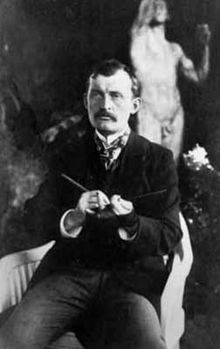











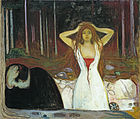
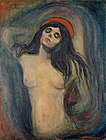





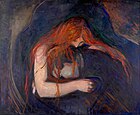
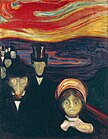



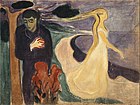

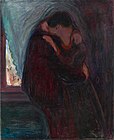


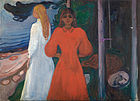
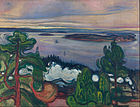

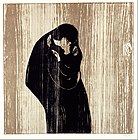



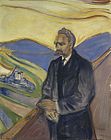








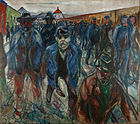








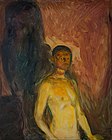


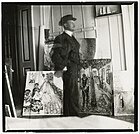
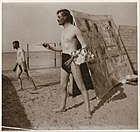




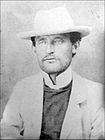


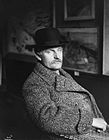










No comments:
Post a Comment